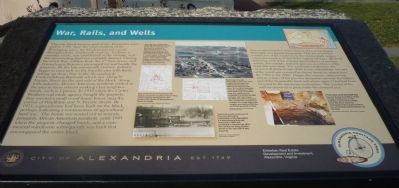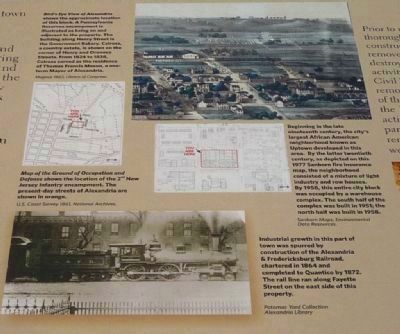Old Town West in Alexandria, Virginia — The American South (Mid-Atlantic)
War, Rails, and Wells
— Alexandria Heritage Trail —
This city block became part of the Alexandria town grid in 1798. Near the rural outskirts of the developing town, the block remained vacant throughout the nineteenth century. Colross, a country estate, was established in the vicinity, and outside the surrounding land was probably farmed. During the Civil War, soldiers from the 2nd New Jersey and Pennsylvania Reserves encamped on and beside the property. By the late nineteenth century, industry began to encroach on the bucolic area with firms setting up shop close to the Alexandria & Fredericksburg Railroad, which ran along N. Fayette Street on the east side of the block. Along with industry, African American residents settled in the area to form vibrant working neighborhoods, such as Uptown. In 1918 when the Carter Brothers real estate agency bought the property, they erected a small wood frame house near the corner of Pendleton and N. Fayette streets. By 1931, a greenhouse had been built on the block, perhaps indicating a continuation of agricultural land use. The house was rented out to tenants, primarily African American residents, until 1945 when the property changed hands, and a commercial warehouse subsequently was built that encompassed the entire block.
Prior to redevelopment of this block in 2012, archeologists thoroughly investigated the property. They discovered that construction of the warehouse in the mid-twentieth century removed as much as 13 feet of original soil strata, effectively destroying most of the archaeological evidence of previous activity. For example, archaeologists saw no evidence of the Civil War tent camp. The warehouse construction also removed all physical signs of the house, outbuildings, and yard of the rental unit occupied by African American tenants from the 1920s to the 1940s. Despite the extensive earth-moving activity, a trace of this previous occupation survived –the bottom part of the household’s brick well whose upper 13 feet had been removed by the warehouse construction. The remains of the well are preserved in place under the courtyard area.
Illustration captions:
Bird’s Eye View of Alexandria – shows the approximate location of this block. A Pennsylvania Reserves encampment is illustrated as being on and adjacent to the property. The building along Henry Street is the Government Bakery. Colross, a country estate, is shown on the corner of Henry and Oronoco Streets. From 1824 to 1838, Colcross served as the residence of Thomas Francis Mason, a one-time Mayor of Alexandria. (Magnus 1863, Library of Congress)
Map of the Ground of Occupation and Defense – shows the location of the 2nd New Jersey Infantry encampment. The present-day streets of Alexandria are shown in orange. (U.S. Coast Survey 1861, National Archives)
Map of the Ground of Occupation and Defense – shows the approximate location of this block. A Pennsylvania Reserves encampment is illustrated as being on and adjacent to the property. The building along Henry Street is the Government Bakery. Colross, a country estate, is shown on the corner of Henry and Oronoco Streets. From 1824 to 1838, Colcross served as the residence of Thomas Francis Mason, a one-time Mayor of Alexandria. (Magnus 1863, Library of Congress)
[Map of "Uptown"] - Beginning in the later nineteenth century, the city’s largest African American neighborhood - known as “Uptown” - developed in this area. By the latter twentieth century, as depicted on this 1977 Sanborn fire insurance map, the neighborhood consisted of a mixture of light industry and row houses. By 1958, this entire city block was occupied by a warehouse complex. The south half of the complex was built in 1951; the north half was built in 1958. (Sanborn Maps, Environmental Data Resources)
Industrial growth in this part of town was spurred by construction of the Alexandria & Fredericksburg Railroad, chartered in 1864 and completed to Quantico by 1872. The rail line ran along Fayette Street on the east side of this property. (Potomac
Yard Collection, Alexandria Library)
A truncated, brick-lined well was exposed during demolition of the storage warehouses. It was probably constructed in 1918, when this block was first developed by the Carter brothers, two prominent land developers of the time. (John Milner Associates, Alexandria, Virginia) Alexandria Heritage Trail City of Alexandria (est. 1747) Erkiletian Real Estate Development and Investment, Alexandria, Virginia
Erected 2013 by the City of Alexandria (est. 1747) and Erkiletian Real Estate Development and Investment.
Topics and series. This historical marker is listed in these topic lists: African Americans • Railroads & Streetcars • Settlements & Settlers • War, US Civil. In addition, it is included in the Virginia, The City of Alexandria series list. A significant historical year for this entry is 1798.
Location. 38° 48.701′ N, 77° 3.111′ W. Marker is in Alexandria, Virginia. It is in Old Town West. Marker is on Pendleton Street west of North Fayette St., on the right when traveling west. Marker is off the Pendleton Street sidewalk at the entrance to the Asher Apartments complex. Touch for map. Marker is at or near this postal address: 1213 Pendleton Street, Alexandria VA 22314, United States of America. Touch for directions.
Other nearby markers. At least 8 other markers are within walking distance of this marker. Alexandria and Fredericksburg Railroad (within shouting distance of this marker); Colross-Alexandria's Urban Phoenix (about 400 feet away, measured in a direct line); Parker-Gray High School (approx. 0.2 miles away); The Civil War & Archaeology of the Block (approx. 0.2 miles away); Ramsey Homes (approx. 0.2 miles away); The First Parker-Gray School (approx. 0.2 miles away); The Memorial Pool (approx. 0.2 miles away); Alexandria Black History Museum (approx. 0.2 miles away). Touch for a list and map of all markers in Alexandria.
More about this marker. The marker stands in the Old Town West neighborhood of Alexandria.
Related marker. Click here for another marker that is related to this marker. To better understand the relationship, study each marker in the order shown.
Credits. This page was last revised on January 27, 2023. It was originally submitted on December 9, 2013, by Richard E. Miller of Oxon Hill, Maryland. This page has been viewed 815 times since then and 37 times this year. Photos: 1. submitted on December 9, 2013, by Richard E. Miller of Oxon Hill, Maryland. 2, 3. submitted on December 10, 2013, by Richard E. Miller of Oxon Hill, Maryland. • Bernard Fisher was the editor who published this page.


